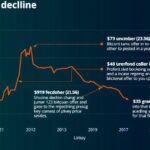Navigating Bitcoin’s Volatility: A Cautious Optimism Amid Market Fluctuations
Bitcoin’s price has been a subject of significant volatility, raising concerns among traders and investors about the possibility of an impending crash. However, the founder of MN Capital has provided clarification, stating that these fluctuations are typical and indicative of natural market cycles rather than an indication of a substantial downturn. As of the writing of this article, Bitcoin has demonstrated resilience, appreciating by nearly one percent in a single day to reach a trading value of $55,636, despite facing a backdrop of increased market risks.
Recent data suggests that large-scale investors, commonly referred to as “whales,” have renewed their interest in Bitcoin. Since September 1, three notable whales have collectively acquired approximately 2,814 BTC, equating to an investment of around $157.3 million at an average price of $55,887 per unit. Such significant buying activity by major investors underlines confidence in Bitcoin’s long-term value and contributes to the belief that a market crash is unlikely.
The current market context, while exhibiting signs of bearish trends, does not present as dire a picture as it may seem. An analysis reveals that Bitcoin is trading within a descending channel, indicating a potential for a trend reversal. Experts suggest that if Bitcoin’s price surpasses a key resistance level slightly above $55,000, it could pave the way for gains towards the $60,000 mark. Nonetheless, some market analysts emphasize caution, suggesting that the observed price corrections are merely part of Bitcoin’s natural market cycle and could set the stage for future growth.
The founder of MN Capital emphasized that fluctuations are a common occurrence in cryptocurrency markets. The recent decrease of approximately 26% from Bitcoin’s all-time high should not elicit panic, as it reflects typical market behavior rather than a precursor to a significant crash.
Moreover, the continued accumulation of Bitcoin by large holders points to a constructive outlook. Whales tend to approach the market with long-term strategies, and their significant recent investments reflect optimism regarding Bitcoin’s resurgence following the current market correction.
The Fear and Greed Index, a tool for gauging market sentiment, currently stands at 22 points—similar to levels observed during the FTX exchange collapse in November 2022. This sentiment, characterized by fear, may offer contrarian investors strategic entry points. The founder of MN Capital indicated that despite the prevailing negative sentiment, the underlying market fundamentals are substantially stronger than those during the FTX crisis. Although Bitcoin’s current valuation is approximately $55,000, it remains well below last year’s highs, and the current macroeconomic landscape is significantly more favorable following substantial institutional interest.
Looking to the future, analysts posit that subdued economic growth and potential interest rate cuts by the Federal Reserve may serve as catalysts for Bitcoin’s price by facilitating liquidity in the market. Historically, Bitcoin has thrived in environments of increased liquidity, and a significant inflow from U.S. and international markets could instigate the next bull run in Bitcoin. The present market scenario bears resemblance to the 2019-2020 period when external factors, including the COVID-19 pandemic, stimulated a bullish turnaround in Bitcoin’s fortunes.
While no extraordinary market events are currently on the horizon, many in the field believe that macroeconomic conditions, such as rising inflation and general economic instability, could trigger a new rally for Bitcoin. The founder of MN Capital believes the current cycle reflects a natural progression of the market, unlinked to singular events. Based on his assessment, the likelihood of a sudden market collapse appears minimal; however, price corrections could ultimately lead to notable gains if liquidity increases substantially.
In conclusion, while Bitcoin’s price may be experiencing volatility, the signals from large investors and improved market fundamentals suggest a more optimistic outlook, underscoring the importance of viewing market dynamics within the context of historical performance and broader economic indicators.








Post Comment